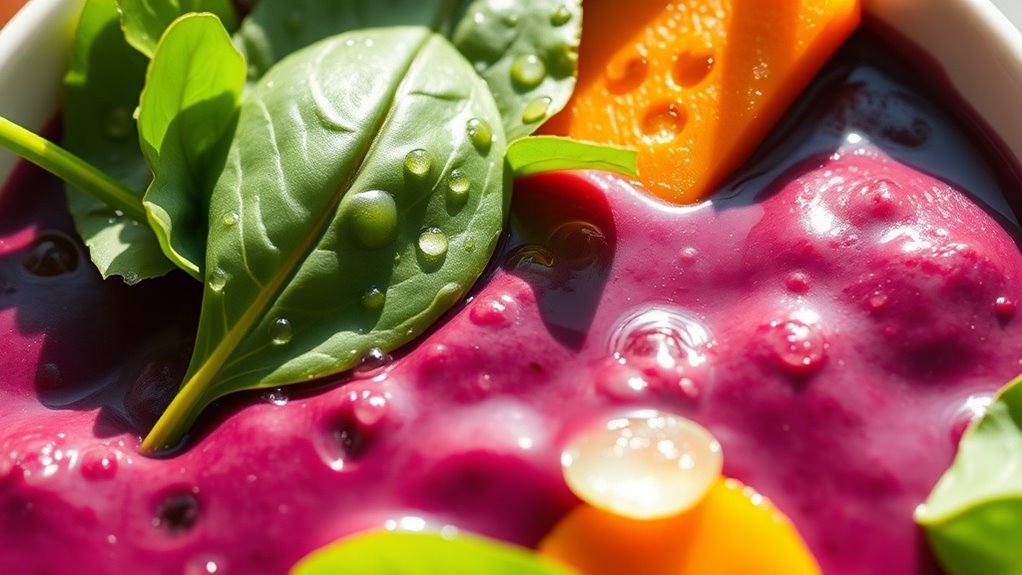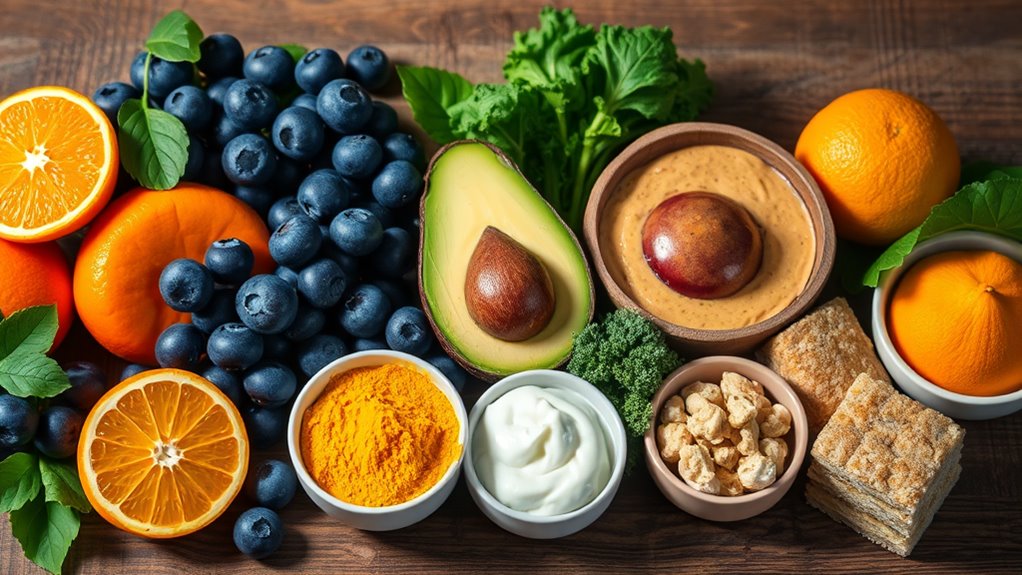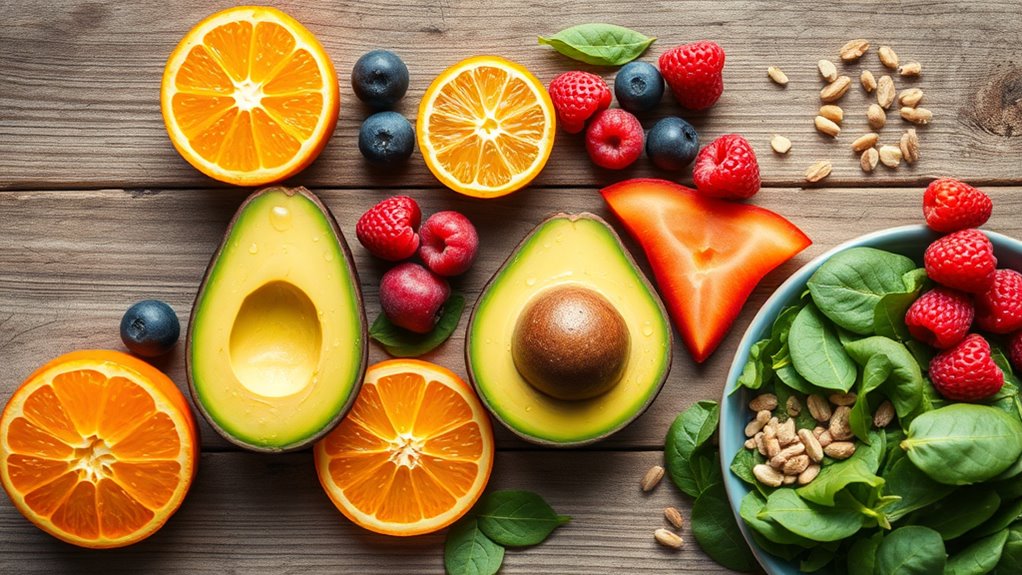10 Foods That Can Trigger Acne You Didn’t Know About
You might be surprised to learn that your diet could be influencing your skin more than you think. Certain common foods, often staples in our daily meals, have been linked to increased acne flare-ups. Evidence suggests that dairy products, sugar, and processed foods play a significant role in skin health. Understanding how these foods affect your body might just change how you think about what’s on your plate next. What other surprising triggers could be lurking in your diet?
Dairy Products
Many people mightn’t realize that dairy products can be a significant trigger for acne. Research indicates that milk, particularly skim milk, contains hormones and bioactive molecules that may stimulate oil production in your skin.
When you consume these acne-causing foods, your body can react with increased inflammation and breakouts. A study published in the “Journal of the American Academy of Dermatology” found a correlation between dairy intake and acne severity.
If you’re prone to acne, it might be worth evaluating your dairy consumption. Consider alternatives like almond or oat milk to see if your skin condition improves. Keeping a food diary could also help you pinpoint whether dairy specifically triggers your acne flare-ups. Additionally, implementing a routine that helps control oily skin can enhance your efforts in managing acne breakouts.
Sugar and Sugary Foods
Although you might enjoy a sweet treat now and then, sugar and sugary foods have been linked to the exacerbation of acne symptoms.
Research shows that high glycemic index (GI) foods, which include sugary snacks and beverages, may increase insulin levels in your body. Elevated insulin can lead to increased sebum production and potentially trigger acne breakouts.
Moreover, sugar can promote inflammation and hormonal fluctuations, further complicating skin health. Studies indicate that individuals consuming diets high in sugar often experience more frequent and severe acne. Additionally, sugar consumption can disrupt the balance of gut bacteria, which may further impact your skin’s clarity.
Processed and Fast Foods
Processed and fast foods pose a significant risk for those prone to acne breakouts, as they often contain high levels of unhealthy fats, refined carbohydrates, and artificial additives. Research indicates that these components can trigger inflammation and hormonal imbalances, both of which may lead to acne development. Additionally, many of these foods can exacerbate inflammation and hormonal imbalances, further complicating skin health.
| Food Type | Common Examples | Effects on Skin |
|---|---|---|
| Snack Foods | Chips, crackers | High in unhealthy fats |
| Sugary Drinks | Sodas, energy drinks | Spike in insulin levels |
| Processed Meats | Hot dogs, burgers | Can increase inflammation |
| Instant Meals | Microwave dinners | High in additives |
Refined Carbohydrates
Refined carbohydrates significantly impact your glycemic index, leading to rapid spikes in blood sugar levels. Common sources include white bread, pastries, and sugary cereals, which can contribute to acne development. Understanding how these foods affect your body can help you make informed dietary choices. Additionally, the consumption of processed foods may increase inflammation, further exacerbating skin issues.
Glycemic Index Impact
When you consume foods high in refined carbohydrates, such as white bread and sugary snacks, your blood sugar levels can rise sharply, triggering a cascade of hormonal responses that may lead to acne.
High glycemic index (GI) foods cause insulin spikes, which can stimulate sebaceous gland activity and increase oil production. This excess oil, combined with dead skin cells and bacteria, can clog your pores.
Research indicates that a diet low in GI, with whole grains and less processed foods, is associated with a reduction in acne severity.
Common Sources Explained
High glycemic index foods, such as white bread and sugary snacks, play a significant role in acne development. When you consume these refined carbohydrates, your blood sugar levels spike, leading to increased insulin production.
This process stimulates sebaceous glands, causing them to produce more oil, which can clog pores and lead to acne. Additionally, these foods often lack essential nutrients that help maintain skin health.
For example, nutrient-dense whole grains provide fiber and vitamins that are beneficial for your skin. By reducing your intake of refined carbohydrates, you can better manage your insulin levels and, consequently, your skin’s oil production.
Focusing on low glycemic index alternatives may support clearer skin and overall health.
Chocolate
When you think about chocolate, it’s essential to consider its sugar content and how it might affect your skin.
Research indicates that high sugar levels can lead to inflammation, potentially exacerbating acne.
However, dark chocolate may offer beneficial effects due to its lower sugar content and antioxidant properties, making it a more favorable choice in your diet.
Sugar Content Impact
Although chocolate is often viewed as a guilty pleasure, its sugar content can play a significant role in triggering acne. High sugar foods can cause spikes in insulin levels, leading to increased oil production and inflammation in your skin. This can create a perfect environment for acne development.
| Sugar Level | Skin Reaction | Potential Outcome |
|---|---|---|
| Low (Dark Chocolate) | Minimal Reaction | Clearer Skin |
| Moderate | Redness/Increased Oil | Mild Breakouts |
| High | Inflammation | Severe Acne |
| Very High | Cystic Acne | Chronic Issues |
| Extreme | Significant Damage | Scarring |
Being mindful of your chocolate choices can help you maintain your skin’s health and potentially avoid breakouts.
Dairy Connection Explained
While chocolate is often enjoyed for its indulgent taste, its dairy content can also contribute to acne development.
Research indicates that dairy products may increase insulin levels and promote inflammation, both of which can exacerbate acne. Cow’s milk, often found in milk chocolate, contains hormones and growth factors that can stimulate oil production in your skin.
This excessive sebum can clog pores, leading to breakouts. Studies show a correlation between high dairy consumption and acne severity, suggesting a potential relationship that shouldn’t be dismissed.
If you’re prone to acne, consider monitoring your chocolate intake, especially varieties high in dairy. By understanding this connection, you can make informed choices to help manage your skin health.
Dark Chocolate Benefits
Despite concerns about chocolate’s potential to trigger acne, dark chocolate offers several health benefits that can positively impact your overall well-being.
Rich in antioxidants, particularly flavonoids, dark chocolate can improve blood flow, enhance skin hydration, and offer UV protection. This unique combination may contribute to healthier skin and a less pronounced inflammation response.
Additionally, moderate consumption has been linked to improved heart health, reducing the risk of cardiovascular issues.
Furthermore, dark chocolate can elevate mood by boosting serotonin levels, which might counteract the stress that sometimes contributes to acne outbreaks.
However, it’s essential to consume dark chocolate in moderation to reap its benefits without exacerbating potential breakouts.
Prioritizing higher cocoa content ensures you maximize these advantageous effects.
Soy Products
Soy products, commonly found in many diets as a source of protein and alternative to animal products, can have a complex relationship with skin health.
Research indicates that soy contains isoflavones, which may impact hormone levels. For some, this hormonal fluctuation can exacerbate acne. Additionally, soy could potentially induce inflammation in sensitive individuals, leading to breakouts.
While many people tolerate soy well, your personal reaction can vary significantly. If you notice increased acne after introducing or consuming soy, it may be wise to limit your intake and monitor your skin’s response.
It’s crucial to remember that diet is just one factor in acne formation; a holistic approach that prioritizes skin health involves considering various influences, including stress and skincare routines.
High-Glycemic Foods
Many people don’t realize that high-glycemic foods can play a significant role in acne development. When you consume these foods, like white bread, sugary snacks, and certain breakfast cereals, your blood sugar spikes rapidly. This triggers insulin production, which may lead to increased oil production in your skin’s sebaceous glands.
Elevated insulin levels can also result in inflammation, further aggravating acne issues. Research suggests a clear link between high-glycemic diets and the prevalence of acne. For those struggling with breakouts, it’s essential to reconsider your carbohydrate choices. Unexpected factors like dietary choices can significantly impact your skin health, making it crucial to assess your eating habits.
Opt for low-glycemic alternatives, such as whole grains, legumes, and most fruits, to maintain stable blood sugar levels and promote healthier skin. This simple dietary adjustment could make a noticeable difference in your complexion.
Fried Foods
Fried foods are often high in oil content, which can contribute to excess sebum production on your skin.
This increased sebum, coupled with the inflammation risks associated with these foods, may create an ideal environment for acne development.
Understanding these connections can help you make more informed dietary choices.
High Oil Content
While indulging in high-oil content foods might seem tempting, it’s crucial to recognize their potential impact on your skin. Foods rich in oils, particularly those that are fried, can exacerbate acne by increasing sebum production.
High oil intake leads to an overabundance of fatty acids, which can clog pores and create an environment conducive to bacterial growth. Studies suggest that diets high in saturated and trans fats are linked to inflammatory skin conditions, including acne.
Increased Inflammation Risk
Excessive consumption of fried foods not only raises oil levels but also significantly increases inflammation risk. This inflammation can exacerbate acne outbreaks by promoting the overproduction of sebum and clogging pores.
Here are three key reasons why fried foods can trigger inflammation:
-
Trans Fats: Many fried foods contain trans fats, which are linked to increased inflammatory markers in the body.
-
Acrylamides: Frying at high temperatures produces acrylamides, compounds known to trigger inflammatory responses.
-
Oxidative Stress: The oil used in frying can create oxidative stress, damaging skin cells and contributing to inflammation.
Bread and Pastries
Many people enjoy bread and pastries, but you mightn’t realize that these staples can contribute to acne flare-ups.
High in refined carbohydrates, most commercially produced breads and pastries can spike your blood sugar levels. This leads to increased insulin production, which may boost oil production in your skin, creating an environment for acne to thrive.
Additionally, many of these baked goods contain additives and preservatives that can trigger skin irritation or allergic reactions in sensitive individuals.
It’s important to consider whole grain or natural alternatives that have lower glycemic indexes. Avoiding mistakes like using harsh products can also be beneficial for healthier oily skin.
Monitoring your intake of these products could help you maintain clearer skin, making it worth paying attention to what you choose to eat.
Omega-6 Fatty Acids
Although omega-6 fatty acids are essential for your body’s functioning, an imbalance in their ratio with omega-3 fatty acids can lead to inflammation, which may exacerbate acne.
Consuming excessive omega-6s while lacking omega-3s can trigger inflammatory responses, directly impacting your skin health.
To maintain a healthier balance and potentially reduce acne flare-ups, consider the following:
- Limit processed oils (like corn, soybean, and sunflower) that are high in omega-6.
- Increase omega-3 intake by consuming fatty fish (like salmon), chia seeds, and walnuts.
- Monitor your overall diet to ensure you’re not disproportionately favoring omega-6 sources.




